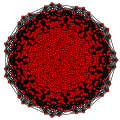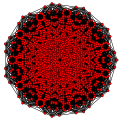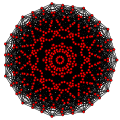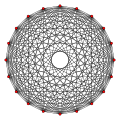Top Qs
Timeline
Chat
Perspective
Uniform 10-polytope
Type of geometrical object From Wikipedia, the free encyclopedia
Remove ads
In ten-dimensional geometry, a 10-polytope is a 10-dimensional polytope whose boundary consists of 9-polytope facets, exactly two such facets meeting at each 8-polytope ridge.
 10-simplex |
 Truncated 10-simplex |
 Rectified 10-simplex | |||||||||
 Cantellated 10-simplex |
 Runcinated 10-simplex | ||||||||||
 Stericated 10-simplex |
 Pentellated 10-simplex |
 Hexicated 10-simplex | |||||||||
 Heptellated 10-simplex |
 Octellated 10-simplex |
 Ennecated 10-simplex | |||||||||
 10-orthoplex |
 Truncated 10-orthoplex |
 Rectified 10-orthoplex | |||||||||
 10-cube |
 Truncated 10-cube |
 Rectified 10-cube | |||||||||
 10-demicube |
 Truncated 10-demicube | ||||||||||
A uniform 10-polytope is one which is vertex-transitive, and constructed from uniform facets.
Remove ads
Regular 10-polytopes
Regular 10-polytopes can be represented by the Schläfli symbol {p,q,r,s,t,u,v,w,x}, with x {p,q,r,s,t,u,v,w} 9-polytope facets around each peak.
There are exactly three such convex regular 10-polytopes:
- {3,3,3,3,3,3,3,3,3} - 10-simplex
- {4,3,3,3,3,3,3,3,3} - 10-cube
- {3,3,3,3,3,3,3,3,4} - 10-orthoplex
There are no nonconvex regular 10-polytopes.
Euler characteristic
The topology of any given 10-polytope is defined by its Betti numbers and torsion coefficients.[1]
The value of the Euler characteristic used to characterise polyhedra does not generalize usefully to higher dimensions, and is zero for all 10-polytopes, whatever their underlying topology. This inadequacy of the Euler characteristic to reliably distinguish between different topologies in higher dimensions led to the discovery of the more sophisticated Betti numbers.[1]
Similarly, the notion of orientability of a polyhedron is insufficient to characterise the surface twistings of toroidal polytopes, and this led to the use of torsion coefficients.[1]
Remove ads
Uniform 10-polytopes by fundamental Coxeter groups
Uniform 10-polytopes with reflective symmetry can be generated by these three Coxeter groups, represented by permutations of rings of the Coxeter-Dynkin diagrams:
Selected regular and uniform 10-polytopes from each family include:
- Simplex family: A10 [39] -



















- 527 uniform 10-polytopes as permutations of rings in the group diagram, including one regular:
- {39} - 10-simplex -



















- {39} - 10-simplex -
- 527 uniform 10-polytopes as permutations of rings in the group diagram, including one regular:
- Hypercube/orthoplex family: B10 [4,38] -



















- 1023 uniform 10-polytopes as permutations of rings in the group diagram, including two regular ones:
- {4,38} - 10-cube or dekeract -



















- {38,4} - 10-orthoplex or decacross -



















- h{4,38} - 10-demicube


















 .
.
- {4,38} - 10-cube or dekeract -
- 1023 uniform 10-polytopes as permutations of rings in the group diagram, including two regular ones:
- Demihypercube D10 family: [37,1,1] -

















- 767 uniform 10-polytopes as permutations of rings in the group diagram, including:
- 17,1 - 10-demicube or demidekeract -

















- 71,1 - 10-orthoplex -

















- 17,1 - 10-demicube or demidekeract -
- 767 uniform 10-polytopes as permutations of rings in the group diagram, including:
The A10 family
Summarize
Perspective
The A10 family has symmetry of order 39,916,800 (11 factorial).
There are 512+16-1=527 forms based on all permutations of the Coxeter-Dynkin diagrams with one or more rings. 31 are shown below: all one and two ringed forms, and the final omnitruncated form. Bowers-style acronym names are given in parentheses for cross-referencing.
Remove ads
The B10 family
Summarize
Perspective
There are 1023 forms based on all permutations of the Coxeter-Dynkin diagrams with one or more rings.
Twelve cases are shown below: ten single-ring (rectified) forms, and two truncations. Bowers-style acronym names are given in parentheses for cross-referencing.
Remove ads
The D10 family
The D10 family has symmetry of order 1,857,945,600 (10 factorial × 29).
This family has 3×256−1=767 Wythoffian uniform polytopes, generated by marking one or more nodes of the D10 Coxeter-Dynkin diagram. Of these, 511 (2×256−1) are repeated from the B10 family and 256 are unique to this family, with 2 listed below. Bowers-style acronym names are given in parentheses for cross-referencing.
Remove ads
Regular and uniform honeycombs
Summarize
Perspective
There are four fundamental affine Coxeter groups that generate regular and uniform tessellations in 9-space:
Regular and uniform tessellations include:
- Regular 9-hypercubic honeycomb, with symbols {4,37,4},



















- Uniform alternated 9-hypercubic honeycomb with symbols h{4,37,4},



















Regular and uniform hyperbolic honeycombs
There are no compact hyperbolic Coxeter groups of rank 10, groups that can generate honeycombs with all finite facets, and a finite vertex figure. However, there are 3 paracompact hyperbolic Coxeter groups of rank 9, each generating uniform honeycombs in 9-space as permutations of rings of the Coxeter diagrams.
| = [31,1,34,32,1]: |
= [4,35,32,1]: |
or = [36,2,1]: |
Three honeycombs from the family, generated by end-ringed Coxeter diagrams are:
Remove ads
References
External links
Wikiwand - on
Seamless Wikipedia browsing. On steroids.
Remove ads



































 ,
,  ...
...




